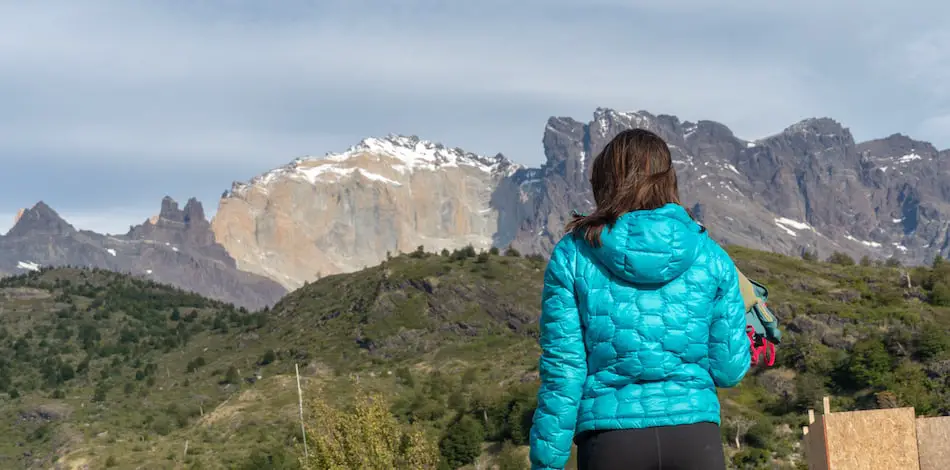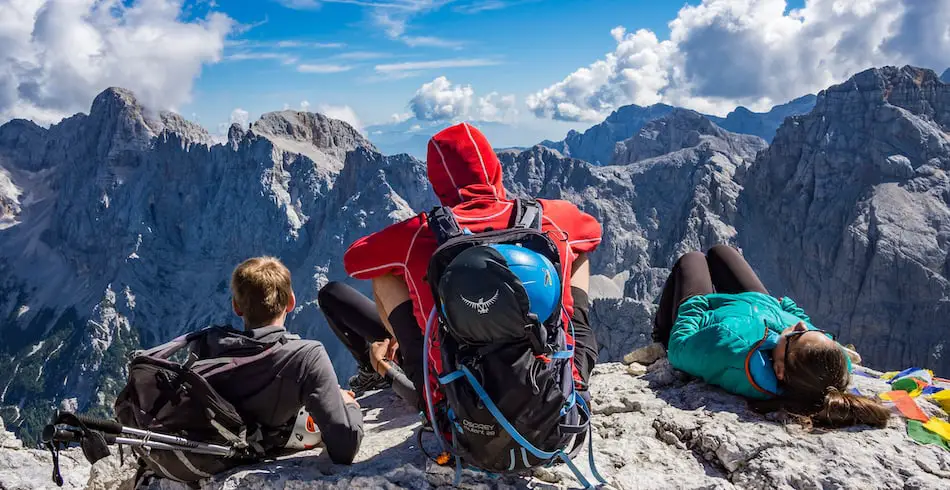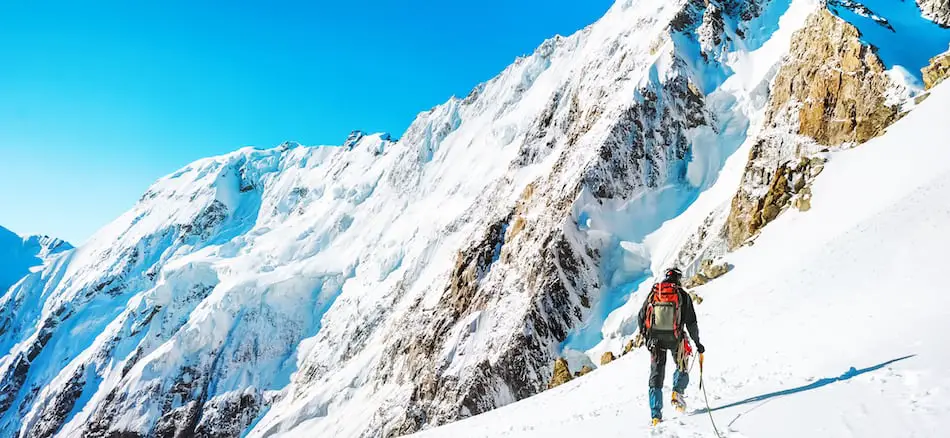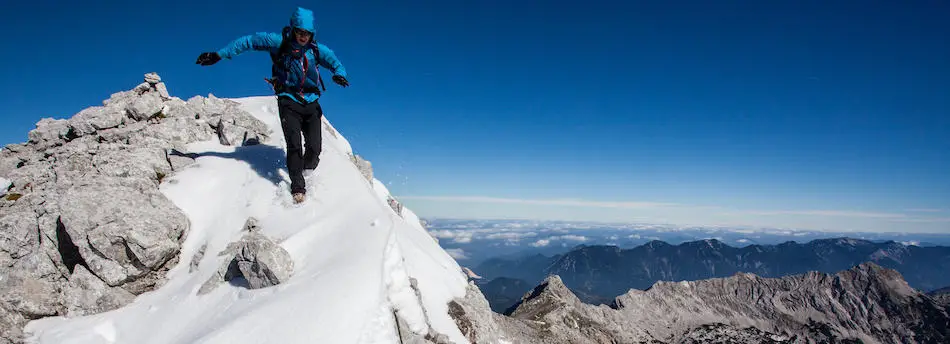
Mountain climbing and mountaineering are two activities that can often get mixed up. I wrote the following article to explain the difference between them!
So, what’s the difference between mountain climbing and mountaineering? Mountaineering is a technical subset of mountain climbing that usually requires specific training and equipment.
While the two sports are very similar in a lot of ways, there are a few key differences between mountain climbing and mountaineering. Essentially, mountain climbing is a broad category of activities that involves travelling to peaks with the intent of reaching the summit, whether it be via hiking, skiing, rock climbing, or any other method. Mountaineering, on the other hand, is a specific subset of mountain climbing that focuses on reaching remote summits via technically difficult routes, often in the winter.
Mountain Climbing vs Mountaineering

To understand the differences between the two activities, it’s best first to define them individually:
- Mountain climbing is simply ‘the set of activities that involves ascending mountains’. You simply look at a mountain and decide that you want to get to one of the summits; you might do this by hiking, scrambling, or mountaineering.
- Mountaineering is a technical activity used to achieve the hardest-to-reach summits. This can include using advanced techniques or specific equipment to make it easier and safer.
To boil it down very simply, there’s an easy distinction to make: just about anyone can mountain climb, while not anyone can mountaineer. Mountain climbing can be as simple as hiking to a summit; there are thousands of mountains with low elevation and well-defined trails that can be reached by almost anybody.
Mountaineering, on the other hand, involves years of practice and experience before you can engage in it. There’s a list of skills you need to memorize, such as:
- Ice climbing
- Ropework and belaying
- Glacier travel
- Placing protection
These are all difficult things to learn and they can take years to perfect.
Mountain Climbing

As a non-technical activity, mountain climbing is great for its accessibility and ease of performance. It’s also a massively varied activity that can be broken down into many other more niche forms:
- Hiking: Like I said, hiking is probably the most basic form of mountain climbing. These hikes can range from very easy to very challenging (while still being non-technical — Mount Whitney is a great example of a non-technical mountain that will still push you to your limit).
- Rock climbing: Rock climbing is when you use ropes and harnesses to scale sheer rock cliffs. It’s a more technical discipline, but it’s a lot of fun!
- Scrambling: Scrambling is a grey zone between hiking and rock climbing: it’s too technical to be considered a hike, but it’s not technical enough to require all of the standard mountaineering gear. For more info, check out my guide here.
- Trekking: Trekking is a form of mountain climbing where you summit multiple peaks over the course of several days, carrying all of your equipment with you as you go.
- Ice climbing: Sometimes, it may be possible to summit a mountain purely through ice climbing — using sharp axes and crampons to ascend vertical sheets of ice.
- Mountaineering: See below.
Mountaineering

Mountaineering is perhaps the most technical form of mountain climbing, because it requires that you be good at all of the other forms. To mountaineer, you need to be a strong hiker, competent rock/ice climber, and a good scrambler.
In fact, you might be required to mix these disciplines together on a specific route. To reach a summit while mountaineering you might have to hike for long sections, rock climb, and scramble through exposed terrain. What’s more, there are some other skills that you also might be required to integrate:
- Glacier travel: Crossing glaciers — massive, frozen rivers — is a dangerous task. Hidden underneath a thin layer of snow on the top, you’ll often find crevasses that are hundreds of feet deep; a fall into one of these could very well be fatal.
- Orienteering: Navigating while on mountaineer can be a difficult task with very high stakes; going off route could well land you in highly technical terrain that could put you in danger.
- Mixed climbing: Mixed climbing is a hybrid activity where you climb on rock using ice climbing tools. It’s strenuous and dangerous.
This is one of the things that distinguishes mountaineering from mountain climbing: it’s a highly technical, dangerous activity that requires years of practice to be able to perform. While just about anyone could leave the house tomorrow morning and go climb a mountain, becoming a mountaineer takes years of practice and work.
Mountaineering is also an activity that often has high consequences. Every year, hundreds of people die while mountaineering, speaking to just how dangerous the sport is.
The benefits of it, however, are often enough to outweigh the risks (which is why so many people love doing it!). Mountaineering will take you to some of the most spectacular, hard-to-reach corners of the earth.
You’ll get to experience sights that only a handful of people have ever experienced before; you’ll also get a massive sense of personal achievement from having scaled tall, technically difficult peaks that most people can only dream of scaring.
If you enjoy mountain climbing and like the challenge/sense of achievement that comes from reaching the summit, turning to mountaineering can be a great way to continue to push yourself and improve!
Similarities

So, now that we’ve broken down the two sports in more detail, I thought it would be good to look at some of the similarities and differences between them.
First we’re going to start with the similarities; because mountaineering is a subset of mountain climbing, there are a lot of ways in which the two are alike. Three of the main ones are:
- Location
- Goal
- Type of Activity
Location
This one’s a bit obvious, but both sports take place in the mountains (for obvious reasons). Now, I’ve had the pleasure in growing up in the mountains, and I’ve completely fallen in love with them; getting to spend time in them is a pleasure, and both mountain climbing and mountaineering are a good way to do so.
However, mountains can also be dangerous. Even the non-technical sport of mountain climbing can involve its own risk, and people get injured/die each year while on hikes and non-technical mountains.
Basic Goal
At their core, the basic goal of mountaineering and mountain climbing are the same: to reach the summit of a tall mountain.
In fact, the activity can be even more niche or specific than that. For both activities, you don’t always need to reach the summit to achieve your goal: sometimes you may choose to focus on one specific route, or a sub-peak.
Also, you should avoid becoming overly focused on the summit! While mountaineering or mountain climbing, as cliché as it is to say, the journey is the true destination. If you become too focused on the summit, you might take unnecessary risks to reach it and put yourself in danger.
Type of Activity
Probably the main similarity between them is that, and their core, mountaineering and mountain climbing are basically the same thing (with mountaineering just being a more specified, demanding version of mountain climbing).
Because of this, there’s a large overlap between people who practice either sport, and mountain climbing is often a common starting point for people who want to begin mountaineering.
Differences

Now let’s talk about some of the ways in which the sports differ.
Risk
As I’ve said before in this article, mountaineering is significantly more dangerous while mountain climbing. That’s not to downplay the risk of mountain climbing; earlier this summer, I almost died when I got off-route on a non-technical mountain climb.
Rather, it’s just a testament to how dangerous mountaineering truly is. While you should be aware of the risks when mountain climbing, you need to be expecting risks when you go mountaineering. Each time you step out of the house on a mountaineering expedition, you should know that you’ll find yourself in situations where death is a serious possibility that should be considered.
So, while mountaineering can take you farther and may end up being more rewarding, it’s also riskier and should be taken more seriously.
Skills Needed
As a more technical activity, mountaineering requires more skills. While mountain climbing might only require the ability to walk (which most of us have) and a certain level of fitness, mountaineering will require a slew of skills including:
- Rock climbing
- Placing protection
- Ice climbing
- Mixed climbing
- Glacier travel
- Navigation
- Risk assessment
- Rappelling
- Emergency rescue
- Scrambling
Equipment Needed
Similarly, mountaineering requires a lot more equipment than mountain climbing does. I have more detailed articles written about each other these topics here and here, but the gist of it is this: while most people could go climb a mountain with stuff that they already have in their house (running shoes, a backpack, a water bottle), mountaineering requires far more equipment.
Some of the gear you need to mountaineer includes:
- An ice axe
- Crampons
- Specific boots
- High-quality winter clothing
- Skis
- Climbing rope
- Snow, ice, and rock anchors
- A belay device
